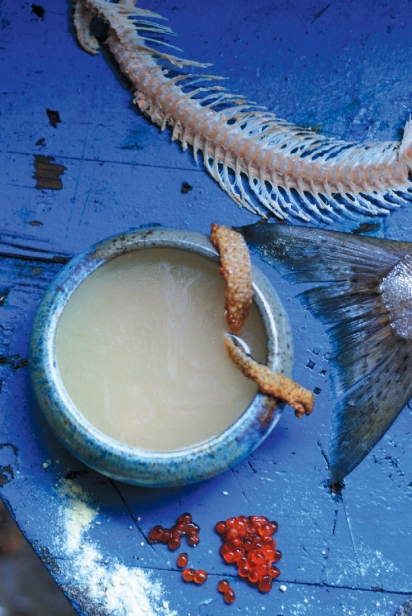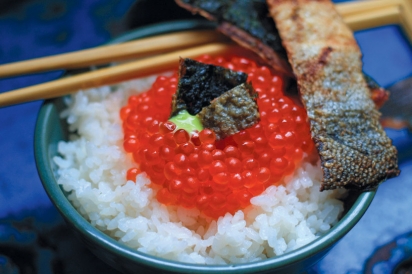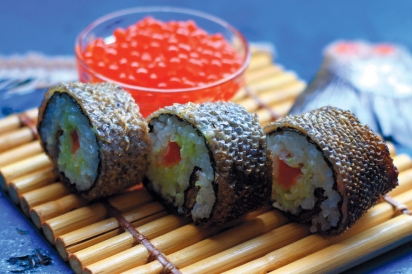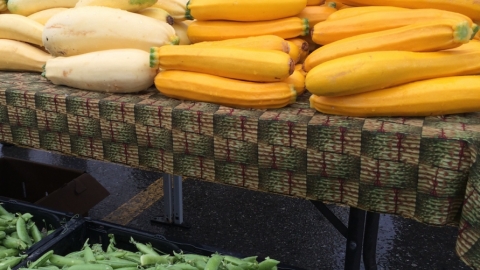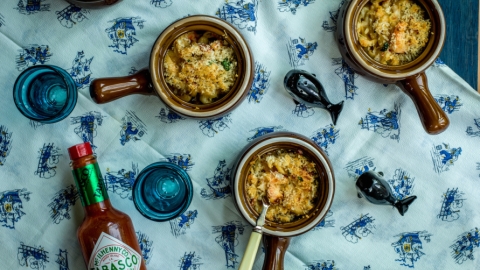Salmon in Pieces
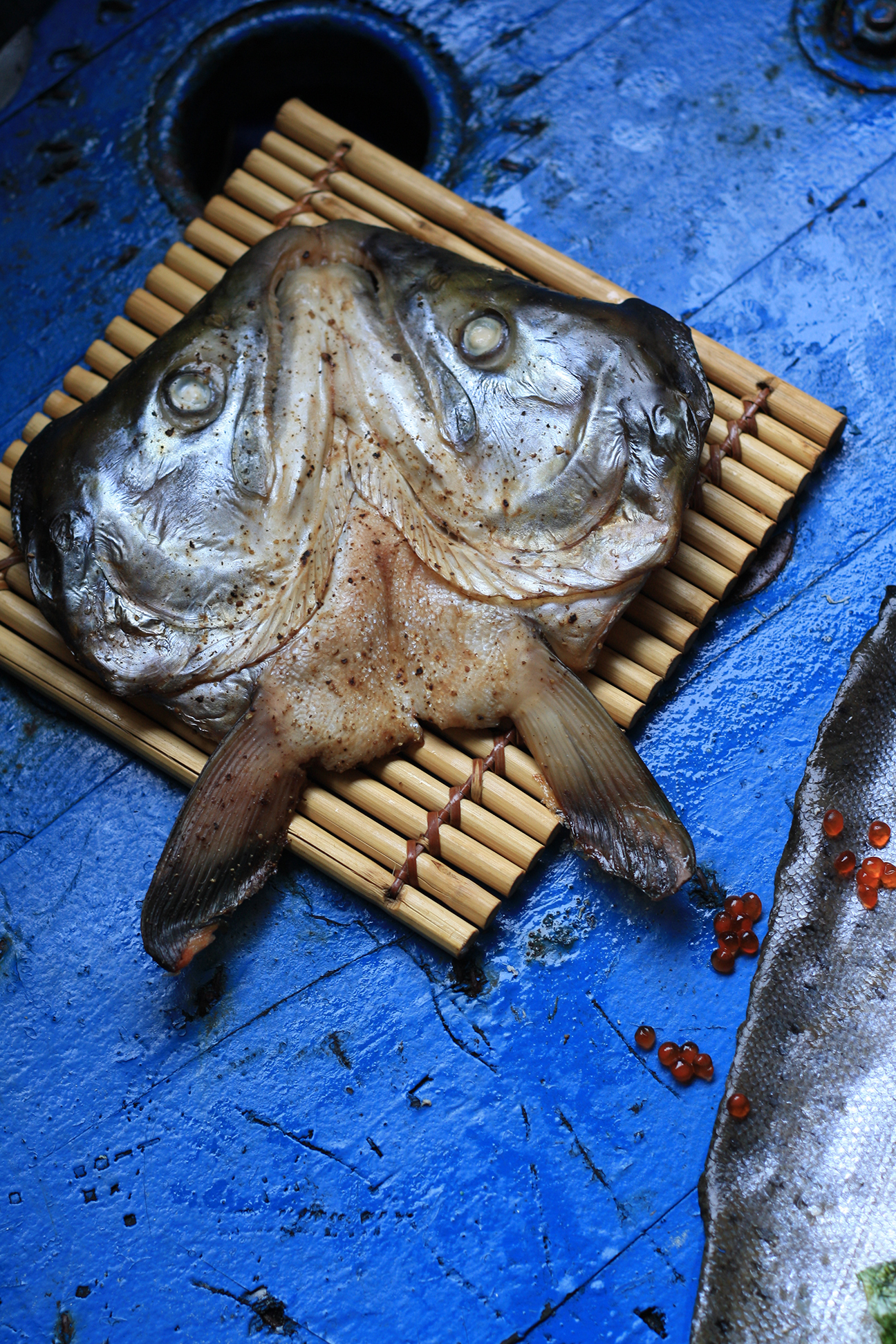
HEADS
When the Nushagak kings hit the beaches on the Westside of Bristol Bay, the whole region seems to buzz in excitement. People with subsistence nets in the water celebrate their first fish by lighting smokehouses and throwing BBQs. A culture of sharing is ever apparent, and social media explodes with photos of the massive silver fish. In so many kitchens, king heads are baked with drops of rich fat sizzling from the collars, cheeks plucked out from under the face plates and savored for their moist flesh. If you miss out on the king salmon, whose heads can be nearly enough to feed three people, coho heads also offer an abundance of meat
To bake salmon heads, preheat your oven to 375º F. Sever the head from the backbone and rinse in cool water, paying special attention to cleaning the gill plate. Once cleaned, you can split the head in half in two ways. One is by placing the cut side onto a cutting board and cleaving straight through the nose, entirely separating both sides of the face so you have two pieces. The second way is by placing it onto a cutting board jaw down and cutting through from the top of the head until just the inside of collar is exposed, leaving the pieces connected by the throat’s flesh.
Place your split heads cut side down onto a cookie sheet lined with parchment paper. Season the skin and collar meat as desired, then bake for 15-30 minutes, depending on head size. You will know they are finished by the delicious scent filling your kitchen and by checking the collar meat to see if it has gained a pale pink appearance.
A steaming bowl of rice ladled over with yellow vegetable curry, a half of a salmon head on top seasoned generously with sprinkles of curry powder, salt, paprika, turmeric, and white pepper, and finished off with a scoop of plain yogurt and raw cabbage slivers makes for a jaw dropping dish on a blustery Alaska summer day.
BONES, FINS, & GUTS
Often a day’s catch is more than one wants to fillet without a break. Gutting and cleaning the bloodline from a salmon allows for a bit of flexibility, as long as the fish has been correctly bled and kept iced or properly refrigerated.
Guts make fantastic additions to compost piles, providing rich nutrients for microbial growth. They generate almost no lure for animals if turned properly, although that is a story for another day.
Blood water hosed from cleaning tables can be poured directly into gardens for an excellent fertilizing hydration solution.
If gutted prior to filleting, only the head, backbone, and tail will remain after the side meat has been sliced away. Often discarded, these pieces can also be composted, although they are better utilized by making a fumet or dashi, otherwise known as fish stock.
To make salmon stock, fill a heavy bottomed pot (with a tight-fitting lid) with enough water to cover the fish parts to be boiled. Heads, backbones, tails, and skins can all be tossed into the pot. Gill plates should be cut from salmon heads to prevent any off flavors from occurring.
Bring water to a rolling boil, reduce to a simmer, cover and allow to cook until all the bones appear to have been cleaned. This may take an hour or up to several, depending on batch size. Strain and fill sterile jars or freezer bags for storage.
Fish stock can be pressure canned using the same methods one would use for pressure canning salmon meat or it can be frozen for up to 6 months.
Stock can be seasoned during its simmer with kelp or nori to create a Japanese dashi, or with herbs and vegetable scraps to create a French fumet. Salmon stock makes an excellent base for seafood chowders, bisques, or miso soup.
ROE
While gutting or filleting your salmon, it is easy to spot a female filled with eggs originally bound for the spawning grounds. These eggs are bursting with flavor and are often enjoyed boiled with rice or kelp in traditional meals, but shine most when brined into ikura.
Making ikura, or cured salmon roe, while a somewhat lengthy process, is worth every glorious bead of glistening sunshine it produces. Like so many things that are unassumingly extravagant, ikura preparation seems daunting, but really is quite uncomplicated. Skeins can be frozen whole to be prepared later or ikura can be made fresh, the same day as the catch.
To make ikura, the roe must first be separated from the skein’s membrane and rinsed. The easiest way to do this without damaging the fragile roe is to place one skein at a time into a bowl of the hottest water you can stand to have your hands immersed in. This will slightly toughen the roe’s shell. Then, still in the water, carefully tease and roll the roe off the skein. During this process the roe will turn milky in color; this is normal and will reverse during the brine.
Once all the membrane is removed, rinse roe gently in cold water, put in a thin mesh strainer and drain. Place in a clean bowl, add a scant teaspoon of sea salt per skein and stir carefully. The eggs will begin to revert to their original bright clear orange almost immediately. A tablespoon or two of sake per skein and a few teaspoons of soy sauce add additional layers of flavor. Let brine for 30 minutes in the refrigerator, stir again and taste. If too salty, a quick rinse in cold water is permissible or additions of soy sauce or salt can be made, if needed. Return roe to chill for an additional 30 minutes.
If desired, season ikura with some very finely minced garlic, chopped green onions, furikake or wasabi paste – all to taste. Serve on top of rice crackers with soft cheese or gracing rice bowls. It is also a delectable topping for sushi rolls of wrapped rice. Ikura is best stored cold, in airtight containers and eaten as fresh as possible.
SKIN
The first thing an angler or fisherman notices when hauling in a salmon is its silver gleam, skin and scales flashing in the sun. Alaskan artisans make salmon skin leather, baskets, and jewelry, but the adventurous sushi lover can create a roll of this skin, crisply fried, that is a work of art in itself.
To fry salmon skin, remove the skin from a raw fillet in one piece, if able. (If you need a bit of instruction in this technique, hop online for an abundance of resources). You can descale the skin, if desired, by running the dull edge of a knife’s blade against the grain. However, if you leave them, the scales will crisp up along with the skin when fried, becoming nearly unnoticeable.
In a heavy bottomed ceramic, well-seasoned cast iron, or nonstick skillet, heat a light layer of sesame oil over medium high heat until hot, but not smoking. Lay the salmon skin scale side down on a clean surface, rub a bit of wasabi paste on the internal side, then lay a sheet of nori on top. Trim the skin to fit the nori and put the now joined skin/nori combo into the hot oil, scales down. Be careful: the fat will pop while frying and the skin cooks incredibly quickly.
When the skin puffs slightly and browns, flip it using tongs and allow the nori to fry for 10-15 seconds, then remove from pan onto a paper towel. Allow to cool until no longer too hot to touch, layer sushi rice over the nori side, fill roll with sliced salmon, cucumber, wasabi paste, or whatever else suits your fancy. Roll into a sushi roll and cut into bite-sized pieces. Serve immediately with soy sauce for dipping. Crispy skin strips can also be enjoyed hot from the pan on their own, dipped in soy sauce, or perhaps as garnish on a bowl of salmon belly ramen.


